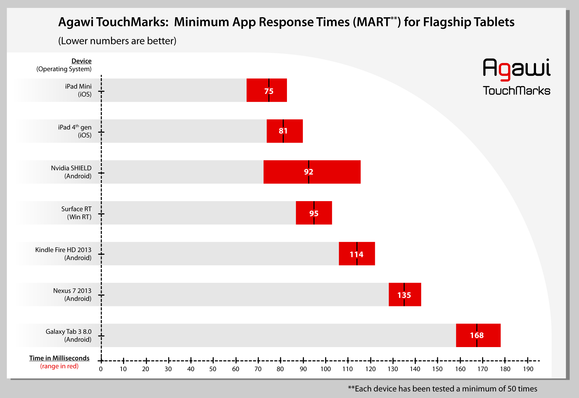apple vs android for tablet touchscreen
- apple vs android for tablet touchscreen
That’s the word from mobile ad platform company Agawi, which is finding a second career as a benchmarking company. In September, Agawi unveiled its first benchmarking report that measured how long it took a smartphone to update its display after a touch interaction; Tuesday, the company released a detailed reportranking tablet touchscreen responsiveness, testing the iPad and iPad Mini, Nvidia's Shield, Kindle Fire HD, Nexus 7, Samsung Galaxy Tab 3, and Microsoft’s Surface RT.
iPad is the touch champ
Just like its smartphone tests, Apple’s iOS took top honors in the tablet TouchMarks showdown. The iPad Mini measured the fastest average touch response time at 75 milliseconds, followed closely by the fourth-generation iPad at 81 milliseconds.

In its tests, Agawi gave high marks to the Shield, ranking it as the most responsive Android-based device with a 92-millisecond response time. The next fastest Android tablet was the latest version of the Kindle Fire HD at 114 milliseconds, followed by the Nexus 7 and Samsung’s Galaxy Tab 3 (8 inch) at a comparatively pitiful 135 and 168 milliseconds, respectively.
Even though it’s a latecomer to the touch tablet craze, Microsoft’s years of developing touch technology helped the Surface RT earn a respectable 95 millisecond response time. That’s not as quick as Apple’s iPad, but was more than enough to destroy the Android-based competition, with the exception of Nvidia’s Shield.
Agawi isn’t quite sure what gives Apple its superior touch performance, but the company speculates that more responsive devices simply process touches as early as possible in the software stack. Touchscreen optimization may also play a role, and the company says it also has some evidence suggesting that a device’s GPU or GPU drivers may add “significant latency” to touch response times.
Whatever the reasons, Agawi advises that anyone with lightweight tablet needs such as reading, watching videos, or browsing the Web will probably be happy virtually any mainstream tablet. Go with what you like, in other words. But if you tend towards data-intensive applications such as gaming or music creation, then you should seriously consider an iPad.
Test everything!

Agawi has already laid out some future plans for its TouchMarks suite to dig deeper into the world of touch, including a retrospective look at response times from the iPhone 3GS to the iPhone 5s. That will be followed by a look at responsiveness in games and game engines, and finally a study of response times for streaming apps and games.
If you want to measure touch responsiveness in the comfort of your own home, Agawi has open-sourced the TouchMarks app code, and plans to release full hardware details at some point in the future.


0 comments:
Post a Comment